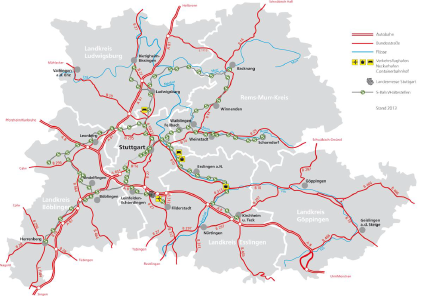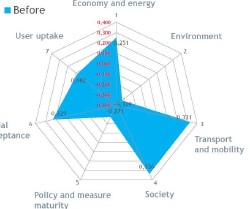STUTTGART FUA
Objectives
•The idea to reduce both CO2 and traffic is seen under the superior goal of enforcing cleaner air.
•Understanding freight traffic flows and its interdependencies with planning and traffic decisions.
•What can we do, and which measures will cause which effects?
•Which cooperations are possible among stakeholders, and how to set them going?
•We were looking for a spatial and economic structure that exists many times across the region, and found it in BadCannstatt (see circle on map).
The territorial context
•2.7 million inhabitants, of which a good 600,000 live in the central city of Stuttgart.
•178 municipalities on 3,650 km2. We also treat the historical town of Bad Cannstattas an entity, although it is not a municipality.
•For research, the FUA was split into 7 zones, from inner Bad Cannstattvia all of Stuttgart City to the outer counties.
•Zones were created in order to allow an understanding of the flows to and from Bad Cannstatt, as a model of the flows to and from the central places.

Results achieved from the Survey on commercial flows
•With over 200 interviews, we covered the retail sector of BadCannstatt. A traffic count separately covered all entrance points of both BadCannstatt inner precincts.
•The contributionof logistics to traffic problems is limited in numbers, but very visible especially in its disruptive potential (e.g. road blocking).
•Even the newer infrastructure (incl. Pedestrian zone) has no loading zones.
•Logistics is still not part of spatial planning issues.
•Almost all deliveries are organized by stakeholders other than the recipients (storechains, parcel services etc.).
•Most delivery vehicles are not by parcel services, but do one-stop deliveries.
•In the shopping mall, logistics works and does not use public space.
FreightQualityPartnership
Involved (expansion foreseen):
•Stuttgart and regionalpublic stakeholders, logistics association, private stakeholders mainly parcel courier business.
Topics:
•Reducing CO2 means electricor bicycle transport,
•Microhubs consolidation of pacels is an option: A micro hub would save 8t of CO2 per van that is made redundant.
•For mixed areas (living and working/shopping): Drop-off pacel stations for private users.
•Local council involved: e.g. temporary stops for delivery vans.
•Private stakeholder are willingto cooperate and to signan agreement.
•Public stakeholders fear any engagement will cause need for same work across the city / region.
Logistics Service Indicator Stuttgart: 0.631
The indicator reflects specifically low levels on environment and on policy and measure maturity, while the transport itself appears operative.

Data interpretation
•Thanks to SULPiTER, for the first time we had data from a full-scale survey, and also it is transferable.
•We were surprised about the small average size of the delivery vehicles.
•Almost all deliveries are made by vans and trucks that do just regional runs, whatever the origin of the ware.
•The delivery vehicles are part of logistics chains that are optimized for the region as a whole. There is no significant logistics hub in close proximity. Thus, the «last miles» in the region are rather long.
•Technically, the system would continue to work in the future, producing traffic and pollution. To reduce CO2-emissions, It needs political decisions. They could create options for better location of interfaces (e.g. micro-hubs) and for different delivery services(e.g. e-bikes).
To read more information about Stuttgart FUA click here
